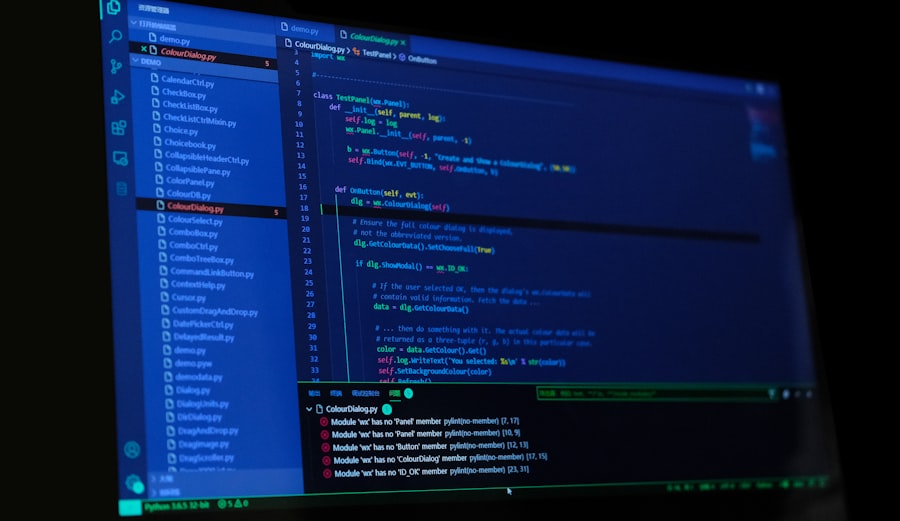The role of a full stack web developer is multifaceted, encompassing a wide range of responsibilities that span both the front-end and back-end of web applications. A full stack developer is not merely a jack-of-all-trades; they are skilled professionals who possess a deep understanding of how various components of a web application interact with one another. This includes knowledge of user interface design, server-side programming, database management, and even deployment strategies.
The ability to navigate through these layers allows full stack developers to create cohesive and functional web applications that meet user needs and business objectives. In addition to technical skills, full stack developers must also possess strong problem-solving abilities and a keen sense of user experience. They often act as a bridge between different teams, such as design, development, and operations, ensuring that all aspects of a project align with the overall vision.
This requires not only technical expertise but also excellent communication skills. As technology continues to evolve, the role of a full stack developer is becoming increasingly vital in the tech industry, as businesses seek professionals who can adapt to changing requirements and deliver comprehensive solutions.
Key Takeaways
- Full stack web developers are responsible for both front-end and back-end development, as well as understanding databases and data management.
- Learning necessary programming languages and technologies is crucial for becoming a successful full stack web developer.
- Mastering front-end development skills involves understanding HTML, CSS, and JavaScript, as well as responsive and user-friendly web application design.
- Back-end development techniques include server-side languages, frameworks, and databases to build and maintain the functionality of a website or web application.
- Understanding databases and data management is essential for full stack web developers to store, organize, and manage data effectively.
Learning the Necessary Programming Languages and Technologies
To become a proficient full stack web developer, one must first acquire a solid foundation in various programming languages and technologies. The journey typically begins with HTML, CSS, and JavaScript, which are the cornerstones of front-end development. HTML provides the structure of web pages, CSS is responsible for styling and layout, while JavaScript adds interactivity and dynamic content.
Mastery of these languages is essential for creating visually appealing and functional user interfaces. Once the basics are established, aspiring developers should delve into frameworks and libraries that enhance their productivity. For instance, React.js and Angular are popular JavaScript frameworks that streamline the process of building complex user interfaces.
On the back end, languages such as Node.js, Python, Ruby, or PHP are commonly used to handle server-side logic. Each language has its strengths; for example, Node.js is known for its non-blocking architecture, making it ideal for real-time applications. Understanding these languages and their ecosystems is crucial for developing robust web applications.
Mastering Front-End Development Skills

Front-end development is where the user interacts with the application, making it imperative for full stack developers to master this domain. Beyond just knowing HTML, CSS, and JavaScript, developers should familiarize themselves with responsive design principles to ensure that applications function seamlessly across various devices and screen sizes. Frameworks like Bootstrap or Tailwind CSS can significantly expedite the process of creating responsive layouts by providing pre-designed components that adhere to modern design standards.
Moreover, front-end developers should also be well-versed in accessibility standards and best practices. This involves ensuring that web applications are usable by individuals with disabilities, which can include implementing keyboard navigation, screen reader compatibility, and color contrast considerations. By prioritizing accessibility, developers not only comply with legal requirements but also enhance the overall user experience for a broader audience.
Additionally, understanding performance optimization techniques—such as minimizing HTTP requests and optimizing images—can lead to faster load times and improved user satisfaction.
Exploring Back-End Development Techniques
| Technique | Description | Benefits |
|---|---|---|
| RESTful API | Architectural style for designing networked applications | Scalability, flexibility, and reusability |
| Database Indexing | Optimizing database performance by reducing the time it takes to retrieve data | Improved query performance and faster data retrieval |
| Load Balancing | Distributing network or application traffic across multiple servers | Improved reliability, scalability, and availability |
| Authentication and Authorization | Verifying the identity of a user and granting access rights | Enhanced security and data protection |
While front-end development focuses on what users see and interact with, back-end development is concerned with the server-side logic that powers these interactions. Full stack developers must understand how to build APIs (Application Programming Interfaces) that allow the front end to communicate with the back end effectively. RESTful APIs are commonly used in modern web applications due to their simplicity and scalability.
Developers should also be familiar with GraphQL as an alternative approach that allows clients to request only the data they need. In addition to API development, back-end developers must manage server environments and understand how to deploy applications effectively. This includes knowledge of cloud services like AWS or Azure, which provide scalable infrastructure for hosting applications.
Familiarity with containerization technologies such as Docker can also be beneficial, as they allow developers to package applications along with their dependencies for consistent deployment across different environments. Understanding these back-end techniques equips full stack developers with the tools necessary to create efficient and scalable web applications.
Understanding Databases and Data Management
Data management is a critical aspect of full stack development, as most web applications rely on databases to store and retrieve information. Full stack developers should be proficient in both SQL (Structured Query Language) for relational databases like MySQL or PostgreSQL and NoSQL databases like MongoDB for unstructured data storage. Each type of database has its use cases; relational databases are ideal for structured data with defined relationships, while NoSQL databases offer flexibility for handling diverse data types.
In addition to database design and querying, understanding data modeling concepts is essential for creating efficient database schemas that optimize performance. Developers should also be aware of data security practices, such as encryption and access control measures, to protect sensitive information stored in databases. By mastering these data management techniques, full stack developers can ensure that their applications not only function correctly but also handle data securely and efficiently.
Practicing Version Control and Collaboration Tools

Mastering Git Commands
Full stack developers should become proficient in using Git commands to manage repositories, create branches for new features or bug fixes, and merge changes back into the main codebase.
Collaboration Tools
Platforms like GitHub or GitLab provide additional functionalities such as issue tracking and pull requests that facilitate collaboration among team members. In addition to Git, familiarity with project management tools like Jira or Trello can enhance a developer’s ability to work within a team environment.
Improving Workflow Efficiency
Effective collaboration is crucial in software development; thus, understanding how to use these tools can significantly improve workflow efficiency and communication among team members.
Developing Problem-Solving and Critical Thinking Skills
At its core, web development is about solving problems—whether it’s debugging code or designing an intuitive user interface. Full stack developers must cultivate strong problem-solving skills to navigate the complexities of building web applications. This often involves breaking down larger problems into smaller, manageable tasks and systematically addressing each one.
Techniques such as rubber duck debugging—explaining your code or problem out loud—can help clarify thoughts and lead to solutions. Critical thinking is equally important in this field. Developers must evaluate different approaches to solving a problem and consider factors such as performance implications, scalability, and maintainability before deciding on a solution.
Engaging in coding challenges or participating in hackathons can sharpen these skills by exposing developers to real-world scenarios where they must think on their feet and devise effective solutions under pressure.
Building Responsive and User-Friendly Web Applications
Creating responsive web applications that provide an excellent user experience is a hallmark of successful full stack development. Responsive design ensures that applications adapt seamlessly to various screen sizes and devices, enhancing usability across platforms. Techniques such as fluid grids, flexible images, and media queries are essential components of responsive design that developers should master.
User experience (UX) design principles also play a significant role in building user-friendly applications. Full stack developers should understand how users interact with their applications and strive to create intuitive navigation structures that guide users effortlessly through their tasks. Conducting usability testing can provide valuable insights into how real users engage with an application, allowing developers to make informed adjustments based on feedback.
Implementing Security Best Practices
Security is a paramount concern in web development; thus, full stack developers must be well-versed in best practices to protect their applications from vulnerabilities. Common threats such as SQL injection attacks or cross-site scripting (XSS) can compromise user data if not properly addressed. Developers should implement input validation techniques to sanitize user inputs and prevent malicious code from being executed.
Additionally, understanding authentication mechanisms—such as OAuth or JWT (JSON Web Tokens)—is crucial for securing user sessions and protecting sensitive information. Regularly updating dependencies and using security tools like static code analyzers can help identify potential vulnerabilities before they become critical issues. By prioritizing security throughout the development process, full stack developers can build robust applications that safeguard user data.
Exploring Career Opportunities and Advancement Paths
The demand for full stack web developers continues to grow as businesses increasingly rely on digital solutions to meet their needs. Career opportunities in this field are diverse; developers can work in various industries ranging from tech startups to established corporations or even freelance as independent contractors. Positions may include roles such as software engineer, web application developer, or technical lead.
Advancement paths for full stack developers can lead to senior developer roles or managerial positions overseeing development teams. Some may choose to specialize further in areas such as DevOps or cloud architecture, while others may transition into product management or UX design roles where they can leverage their technical expertise alongside strategic decision-making skills.
Continuing Education and Professional Development in Full Stack Web Development
The technology landscape is ever-evolving; thus, continuous education is vital for full stack developers who wish to stay relevant in their field. Online platforms like Coursera or Udacity offer courses on emerging technologies and frameworks that can help developers expand their skill sets. Attending workshops or conferences can also provide networking opportunities while exposing developers to new ideas and trends within the industry.
Moreover, engaging with online communities—such as Stack Overflow or GitHub—can foster collaboration and knowledge sharing among peers. Contributing to open-source projects not only enhances coding skills but also builds a portfolio that showcases a developer’s capabilities to potential employers. By committing to lifelong learning and professional development, full stack developers can ensure they remain competitive in an ever-changing job market.












